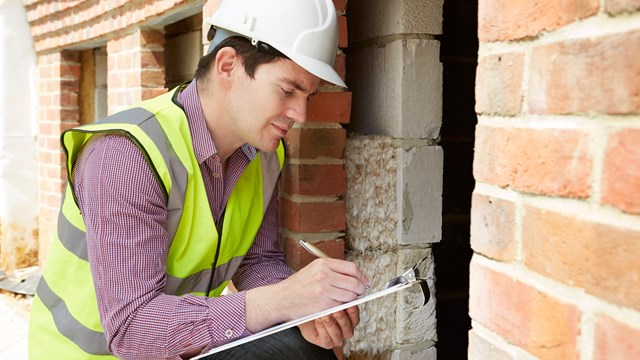Constructed as they are out of materials like brick, concrete, or even stone, the exterior walls of an apartment building or row of townhomes might seem nearly indestructible. But despite their hardiness, walls are not immune to assaults from the elements, and it’s up to their owners to ensure that they’re maintained properly and can perform their intended function. Boards of condominium and cooperative properties, in fact, have a fiduciary duty to look after their building’s envelope, not only to maintain the quality of life within the building, but to preserve residents’ investment in it. To this end, it’s essential to conduct regular inspections of your building’s perimeter, whether that means several times a year in-house, or less frequently and in the presence of a certified professional. Cracks in the facade are not just a metaphor, after all – they’re a real problem that can cost thousands in damages if not caught and fixed.
The Frequency Question
How and when to take a closer look at the outside of your building depends on several factors, including the age, location and make-up of the structure. Ideally, a board will enlist the help of a bona fide property manager to help ease the burden of keeping up with this grind.
“No matter where a building is located, its facade – and I’ll include roofs as well, which I refer to as the exterior envelope – should be inspected on an ongoing basis,” says Doug Weinstein, vice president of operations at Project Management Group, part of AKAM Living Services, Inc., which has offices in Florida and New York. “Different municipalities will have different regulations as to when and by whom facades need to be inspected. Florida, believe it or not, only requires a 40-year inspection. But regardless of municipal requirements, the exterior envelope should be part of a building’s normal inspection criteria. And depending on the components of the facade – whether it has balconies, terraces, cornices, decorative stone work – the more elaborate its presentation, the more frequently it should be looked at.”
James Cervelli, a principal with Cervelli Real Estate & Property Management in North Bergen, New Jersey, says that despite there not being specific regulations as to when inspections must take place in his area, his firm assigns a manager to walk around the property once per month. “They’ll look for anything that could be perceived as awry or out of place,” he says. “They’ll engage in preventative maintenance to ensure that everything is attached where it needs to be, that there’s no cracking, no loose or protruding cement. It’s a basic overview in order to keep up with any maintenance that may need be scheduled. More intensive inspections, involving an architect or another outside vendor, may take place every seven to 10 years.”
Heavy Hitters
While routine check-ups by in-house staff or management personnel are part and parcel of the maintenance of a building, a spontaneous issue may suddenly arise, giving a board occasion to call in specialists to look at or work on the property. As architects, engineers, contractors and the like can prove costly, it’s important to know when to get in touch, and what to expect.
Jon Boyd, R.A., S.E., P.E.; Peter Power, R.A.; and Todd Gorrell, R.A. are the chairman/CEO, vice president and associate principal, respectively, of Klein and Hoffman, a restoration architectural and engineering firm based in Chicago. According to them, the frequency of exterior inspection depends on the nature of a building’s construction. “If we’re talking about an older masonry structure – especially what we call ‘transition buildings’ that have steel structure in and among the masonry – they can require very frequent close-up inspection,” they say. “An older building that’s pure masonry and doesn’t have a steel structure may require less. By the same token, if it’s a glass and steel high-rise, there may be little to do from a safety perspective, but they can have as many or more problems as older buildings. So it’s all quite dependent on the building type.”
“As a general rule, you’ll want to do a visual inspection on a low- or mid-rise building every few years, with some level close-up inspection maybe once every four,” Klein and Hoffman conclude.
Red Flags
Of course, circumstances can arise that may prompt a board to get a professional involved well ahead of a scheduled inspection. It’s important to know what to look for when it comes to possible indicators of a compromised exterior.
Adam Davis, a project manager with J. Graham Goldsmith Architects, which has locations in Vermont, Massachusetts and Florida, tells boards and managers to look out for staining, especially on the side walls. “Watch out for any sign of deterioration,” he says. “If your building incorporates a natural product, you’ll be able to note the discoloration. During snowstorms, you may observe spots where snow fails to accumulate on roofs. Those are hot-spots that may indicate bad roofing, bad insulation, or some combination of the two.”
“You can also note gaps between bricks in certain structures,” adds Cervelli. “Or that the cement between bricks has begun to deteriorate. If you’re accumulating dampness or moisture inside of an apartment, that deterioration could be the result.”
Klein and Hoffman also urge boards to pay attention to sealants. “Sealants have a limited useful life and have quite often outlived their usefulness by the time we’re called out,” they explain. “That’s something easy for associations to keep tabs on. Because once the sealants go, water is coming into the building, and the damage may be done before we get there. It grows exponentially over time, especially in masonry or exposed concrete construction.”
Additionally, from a masonry standpoint, boards can look for efflorescence, which is the white staining that can accumulate on brick, and is a signal of water penetration into that wall, according to Klein and Hoffman. And on concrete buildings, or on any service where things can corrode, peel or rust, these indications of aging may warrant a look to see if there’s a larger underlying problem.
Another issue which boards and individual owners alike may be inclined to overlook is glass breakage. “Oftentimes unit owners don’t report cracked windows, but that’s a dangerous situation; that window has lost some level of structural capacity,” say Klein and Hoffman. “It may be stable under normal conditions, but add wind, and it’s unpredictable.
“We’ve had cases recently where there’s been spontaneous glass breakage,” they continue. “It happens from impact, or movement of window frames. In Chicago, the building department will cite a building due to broken glass. Many associations, unfortunately, relegate the responsibility for individual panes of glass to the owner, and many owners don’t want to pony up $300 or $400 or even $1,000. But, in my opinion, they have a fiduciary duty to themselves and to the association to identify a piece of broken glass as soon as they know about it.”
And Davis just urges everyone to adhere closely to an architect’s recommendations. “We just had a case wherein a building wrap failed,” he says. “The contractor who’d built it used a substitution for the product we’d specified. But manufacturers of different products vary wildly; one product may work in one area, but not at all in another. This was a case where they should have provided air space between building wrap and siding, and when they failed to do so, it led to major rot.”
Bang for One’s Buck
With the myriad threats to a building’s facade and the various degrees of cost and time that can go into repairing the damage they can cause, it’s important that a board know how to both assess the best vendor to perform a particular job, and allocate its budget accordingly.
“There are a lot of things that need to be done – and done right,” say Klein and Hoffman. “And you need to specifically seek out qualified professionals; many people who go about designing new buildings know virtually nothing about repairing them. The latter is a science and art unto itself – a specialized subset that needs to be correct, as it’s extremely expensive to fix building facades. A very high percentage of what an association spends on a repair goes to just getting the vendor access to the work that needs to be done, so we tell people to spend the money and get it done in one shot, rather than drag it out and have someone come out and install new scaffolding three or four times just to attain that access.”
Where vetting is concerned, Klein and Hoffman recommend reviewing potential vendors’ resumes and assessing the depth of their experience. “You want to see continually demonstrated success, not just stuff they did last year,” they say. “You’ll want references and examples of successful projects that compare to your property and the shape and scope of what you need. And we get recommendations from existing condo clients. Most associations are aware of other, similar associations. Call them up! Ask them how their projects went with their vendors. You’ll find them to be amazingly candid.”
For associations on a tight budget, unsure as to how best approach a potentially costly project, Weinstein evokes the old adage ‘a stitch in time saves nine.’ “The best way to save money is to correct a facade problem when it happens,” he says. “Insurance policies always contain language discussing a ‘failure to maintain,’ and that deals with anything from a plumbing pipe to a facade to a roof problem. If the association or the cooperative failed in any way to maintain the building, and that failure results in a loss of some sort, the insurance company can come back and say that they’re not going to cover the loss due to that failure to maintain. And the association can be on the hook for millions of dollars.”
As a last word of advice for boards of newer associations, Klein and Hoffman recommend that they immediately start saving for a rainy day. “It’s pretty common for a new association to have minimal money put away toward reserves, as it may assume that it won’t have any problems for many years,” they say. “But then they learn that there were flaws in the construction, such that they need to put out large special assessments. And we’re finding that these bigger flaws tend to show up right around the time that a developer’s two- or five-year warranty is gone. It’s at that point that stuff hits the fan.”
Michael Odenthal is a staff writer and reporter for New England Condominium.










Leave a Comment